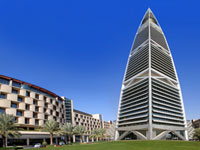 Riyadh OverviewRising from the barren desert, its towering skyscrapers
glittering in the fierce sun, the Saudi Arabian capital, Riyadh, is
one of the most splendid and affluent cities in the modern world,
sprawling across about 600 square miles (1,600 square kilometres)
of desert in the heart of the Arabian Peninsula. Once a small oasis known for its date orchards (hence the origin
of its name which in Arabic means 'place of gardens'), Riyadh's
phenomenal growth spurt began in 1902 when the desert lord Ibn Saud
took over the city determined to turn it into the centre of his
Arabic kingdom. Thirty years later it became the capital of the new
country of Saudi Arabia, and fuelled by the revenue of the
country's abundant oil fields, it has burgeoned into an awesome
modern metropolis with a population well in excess of four
million. Modern it may be, but visitors to Riyadh are never likely to
forget that they are in the heart of the Arab world. In between the
towering, futuristic buildings, glitzy shopping malls and broad,
sweeping highways are nestled ancient mosques and other remnants of
times gone by, shady trees and date palms line the avenues, and
camels sometimes sway between the luxury vehicles. The city is also
run on a strictly Islamic moral and cultural code, and visitors
should respect the rules while exploring the sights, both ancient
and modern, in this fascinating city. Women have restricted access
to certain attractions and sites. The original 'wadis' (dry river beds), where wells were sunk to
water the historic infant oasis settlement, have now been
supplemented by numerous vast dams and piped in desalinated
seawater to adequately quench the thirst of this prosperous
capital, quite justly dubbed 'Queen of the Desert'. Travellers can
therefore drink deeply of this unique urban landscape, which will
not be found wanting in both historic interest and modern
wonder. |